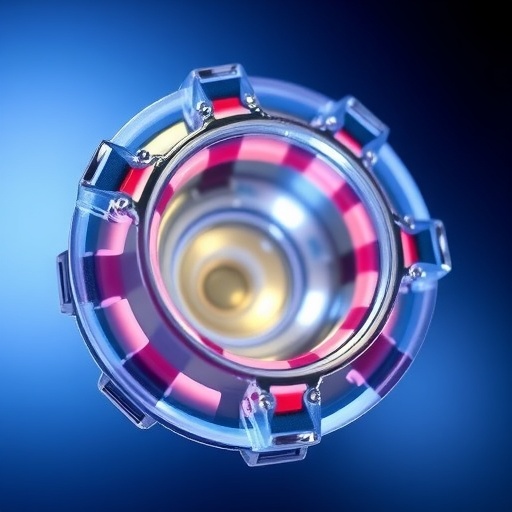In a groundbreaking study published in the Journal of Artificial Organs, researchers led by Y. Sato, alongside co-authors Y. Inoue and T. Terazawa, have made significant advancements in the field of tissue engineering by developing transcatheter implantable autologous tissue-engineered pulmonary valves. This innovative approach utilizes in-body tissue architecture, which could potentially revolutionize cardiac treatment by providing patients with custom-made solutions that improve success rates and lifespan.
The heart plays a critical role in human physiology, and any malfunction within its structure can lead to dire health consequences. Traditional replacements for damaged pulmonary valves often involve mechanical or donor valves, which come with a range of complications including rejection, limited durability, and the necessity for long-term anticoagulation therapy. By tapping into the body’s inherent abilities to heal and regenerate, the researchers aimed to create an alternative that minimizes these risks and promotes natural integration.
The study’s primary focus was on harnessing the patient’s own cells to fabricate the pulmonary valves, promoting biocompatibility and reducing the chances of immune rejection. The researchers developed a sophisticated method for harvesting stem cells from patients, which were then differentiated into suitable cardiac tissue. By doing this, Sato and colleagues not only utilized the body’s own healing mechanisms but also ensured that the engineered valves would be functionally and histologically appropriate for heart function.
The researchers employed a novel transcatheter approach, allowing the delivery of these pulmonary valves via a minimally invasive procedure. This technique significantly reduces recovery times and postoperative complications associated with traditional open-heart surgery. Moreover, the transcatheter method allows for real-time monitoring and adjustments during implantation, providing an unprecedented level of precision in cardiac interventions.
The team’s design leveraged advanced three-dimensional printing technology, which enabled the creation of scaffolds mimicking the complex architecture of natural pulmonary valves. This sophistication is crucial, as the biomechanical properties of valves can determine their longevity and compatibility with surrounding tissue. The use of biodegradable materials in the scaffolding process allowed for gradual integration with the patient’s natural tissue, ensuring that the transcatheter valves function effectively in the dynamic environment of the heart.
One of the core innovations of this study lies in the incorporation of in-body tissue architecture when fabricating these valves. By mimicking the natural extracellular matrix, this technique enables the engineered valves to encourage cell growth and proliferation. Such an approach tempts the body to treat the new valve as part of its own structure, significantly enhancing the longevity and functionality of the implant.
Moreover, the researchers presented substantial preclinical data demonstrating that the new valves successfully exhibited excellent hemodynamic properties. They addressed concerns regarding the potential for calcification, a common complication observed with synthetic implants. The study revealed that autologous tissue-engineered valves exhibited significantly reduced calcification compared to conventional alternatives, pointing to their potential for long-term use.
The researchers emphasized the importance of conducting extensive clinical trials to validate their findings and understand the long-term implications of using these valves in human patients. Initial studies on animal models showcased promising results, bolstering their confidence in moving towards human applications. However, the transition from laboratory success to clinical efficacy will require careful examination and experimentation.
Furthermore, the impact of this research extends beyond mere implantation. The use of patients’ own cells minimizes ethical concerns surrounding tissue sourcing, while the development of in-body engineered solutions could potentially vastly improve patient outcomes and revolutionize how we approach heart diseases. Such advancements offer hope for tailored therapies based on individual patient profiles, fostering a new era of personalized medicine.
The status of pulmonary valve replacements and the widespread need for improved methodologies in treating heart valve diseases highlights the timely importance of this research. Cardiovascular diseases remain a leading cause of morbidity and mortality worldwide, making innovative solutions such as those proposed by Sato and his colleagues essential. Their work represents a significant step forward in the quest to provide better options for patients suffering from heart valve dysfunctions.
Industry experts have already begun to take notice of these promising developments, speculating on potential future implications for broader applications in the field of regenerative medicine. The potential for these engineered solutions to be adapted for other types of valves or even for general applications in tissue engineering might transform not just cardiology but various domains within medical practice.
The implications of this research also pave the way for discussions about healthcare policies, insurance coverage for advanced treatments, and the allocation of resources in medical research. If proven successful, the widespread adoption of such transcatheter solutions could lead to decreased healthcare costs over time due to fewer procedures and complications, ultimately benefiting patients both financially and health-wise.
As the medical community reflects on these advances, it’s vital to remain engaged in dialogue regarding the ethical considerations surrounding the use of bioprinting and tissue engineering technologies. While the benefits appear vast, the ensure balance between innovation, patient safety, and ethical practices in research and treatment must remain at the forefront of scientific endeavors.
In conclusion, the study spearheaded by Sato, Inoue, and Terazawa provides a glimmer of hope in the ongoing battle against heart disease. The innovative approach of using autologous tissue-engineered pulmonary valves represents a leap toward more effective, biocompatible, and patient-forward solutions. As research continues to advance and clinical trials unfold, there’s a palpable sense of anticipation regarding the potential for these innovations to reshape the landscape of cardiac treatment in the years to come.
Subject of Research: Development of transcatheter implantable autologous tissue-engineered pulmonary valves.
Article Title: Development of transcatheter implantable autologous tissue-engineered pulmonary valves using in-body tissue architecture.
Article References:
Sato, Y., Inoue, Y., Terazawa, T. et al. Development of transcatheter implantable autologous tissue-engineered pulmonary valves using in-body tissue architecture.
J Artif Organs 28, 393–401 (2025). https://doi.org/10.1007/s10047-025-01507-w
Image Credits: AI Generated
DOI: https://doi.org/10.1007/s10047-025-01507-w
Keywords: Tissue engineering, pulmonary valves, cardiac treatment, regenerative medicine, biocompatibility, transcatheter approach, personalized medicine, heart disease, autologous solutions, ethical considerations in medicine.




